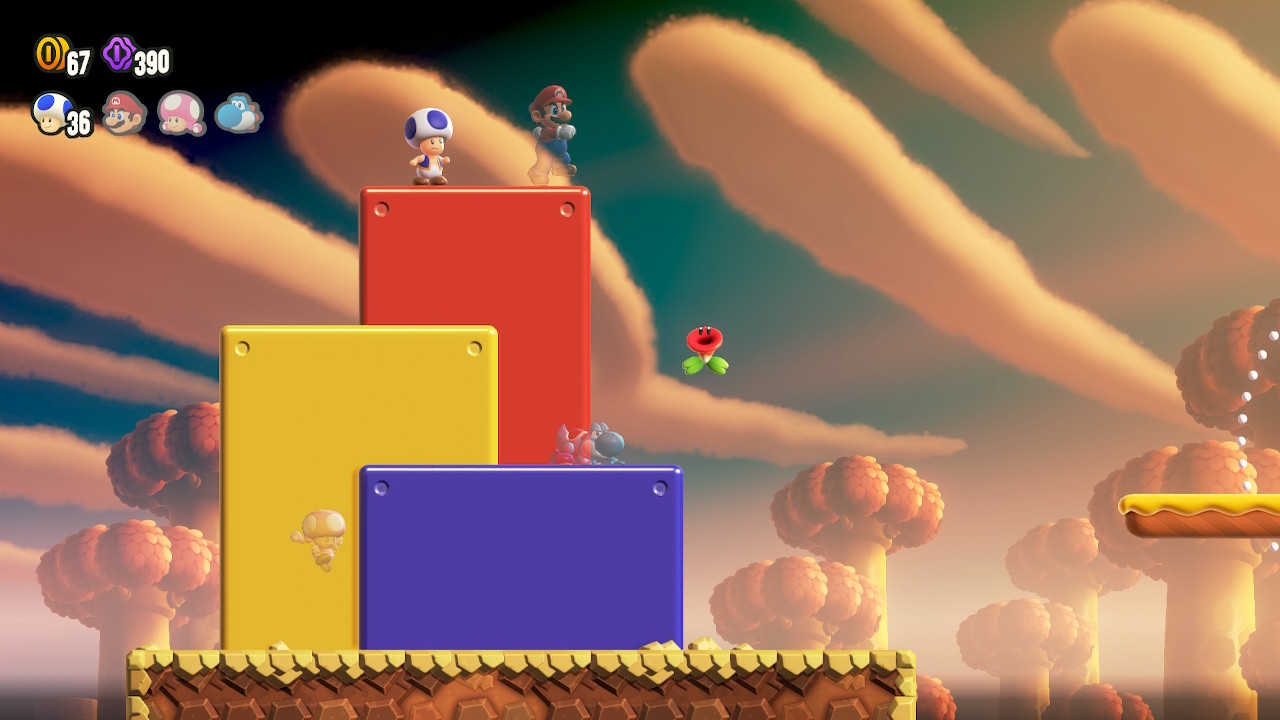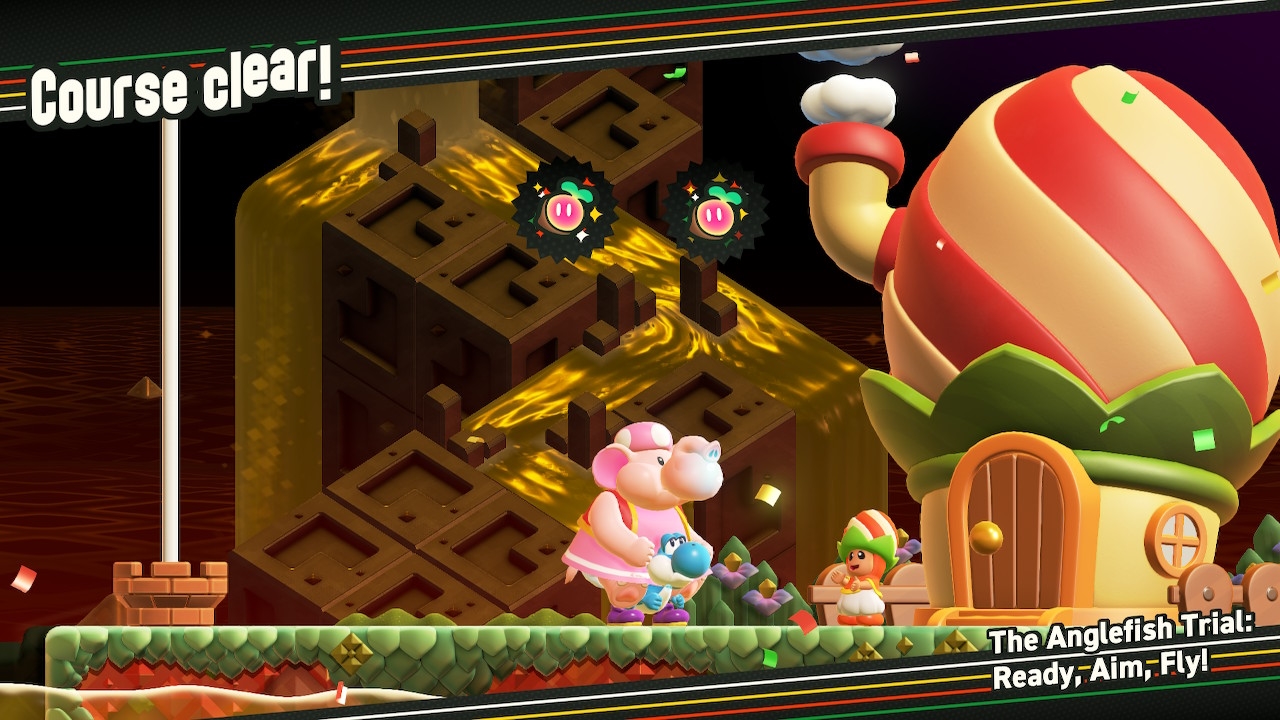
Not every game has to be an MMO. Adding more players in certain contexts really can ruin the experience of a game. But at the same time, anyone who knows me in meatspace knows that I tend to skip the big single-player titles everyone else is talking about. My game time is social time, so if you catch me playing something that I’m not being paid to write about, it’s still often at least local co-op, and only at parties.
But now Nintendo’s released Super Mario Bros. Wonder, allowing me to play a series and genre that’s both popular with the single-player crowd and has very direct, real-time multiplayer benefits I didn’t think I was missing in my non-MMO/online gaming experience. And I like it.
A whole new Wonder-ful world
I won’t sit here and explain side-scrolling platformers or basic Mario games, as I know most of our readers are more than familiar with them (and some of you were were playing them before I could properly hold a controller!). The trailer gives a pretty good overview of the game, particularly some of the very bare basics of online play. But I’d like to get into the guts of the title straightaway because we know Mario and we know online games – but Wonder puts fun twists on old formulas.
It’s not just that you can move between foreground and background or engage in races (either with your friends or against the AI. It’s not even just the rollercoaster-like levels players kept making in Super Mario Maker. I don’t need to tell readers that just by being online and multiplayer you can do some interesting things, as we saw with Super Mario Bros. 35, but this is in a purely co-op fashion (without the PvP).
In some ways, it offers similar features, like dropping items into another players’ game, but that’s just scratching the surface. Some of the new mechanics give the game a vintage beat-’em-up vibe, like sharing items or helping a downed ally. However, those options are still quite simplified; for example, revives require just touching another player or a Standee, which is just a player-based icon acting as a kind of mini-respawn point or even a hint about your surroundings – reminiscent of Soulslike games.
This is because other people playing the level show up as “shadows,” whom you can’t directly harm but can indirectly help. Unlike in Mario 35, you can’t share negative items, but you can share spare power-ups. For example, someone saw me take a couple of bad hits and tossed me a Fire Flower, which made the rest of the level easier. When I play as less vulnerable character like Yoshi (which we’ll get to in a bit), I have no use for most power-ups, so I’ll toss them to little strangers who clearly need the help.
I should note at this point that I honestly can’t remember the last platformer I played even semi-seriously. As few are online and multiplayer, it’s just hard for me to get motivated to play them, even if I kind of miss them. I’m more used to them as party games, such as with Heave Ho! or Pico Park. So far, those two are admittedly more multiplayer but are also limited to far less massive player counts, plus they’re local co-op. They’re still fun, but they don’t have quite the same feeling as an online game I can play from the comfort of my bed and blankets.
That’s the other interesting feeling of Mario Wonder. While I can send emotes and items and rezzes to tons of people, I can also just watch them run around the overworld map or follow along during levels or even see them find secret boxes or alternative paths. Plus, you do get Heart Points every time you give a player an item or rezz them, which feels pretty good even though the points do nothing.
I’m not the one to usually embrace it, but the whole experience can be a very alone-together feeling in a good way: no commitments, no one asking me to group, no guild drama. I can help people as I please or show them a secret location or simply run through a level at full speed.
It bears repeating that this isn’t an MMO. While I’m not sure if there’s a limit to how many players can appear in the overworld, it seems as if four players is the maximum. Series vets will want to know that online players can’t hit you with shells, stomp on your head over a chasm, or take your powerups (aside from when you release one by holding the A button, which makes it appear over your head and easy to immediately take if you don’t wish to share it).
In other words, you don’t have to worry about a million other avatars cluttering your space or potentially griefing you. The very worst I’ve seen is people simply being online and not making good use of Standees while using their fellow players as a rez point. Considering what we’ve seen in other games, I’d say this makes Wonder probably one of the least toxic titles I’ve had the pleasure to cover.
Now, the Switch can be kind of a grey area between console and mobile. The game runs fine on the Switch using my phone’s wifi, but the screen feels a bit small. You also have to worry a bit about syncing pro controllers if you want to use those while playing. The joy-cons are serviceable, especially as the game allows some controller shaking to act as another button, but I do get a bit thrashy when I’m frustrated, so that’s not the best option for me. In that respect, if you’re going to play Wonder solo and online, you’re fine; it’s just a bit weirder to try multiplayer on one screen, particularly if you want to use a full-sized controller.
Same old new thing
If you watched the whole video I linked above, you probably saw some wild things. In the interests of not spoiling it outright, I won’t even touch on the “wonder” parts aside from saying they’re simply a joy to experience. The small twists are usually easy to get but still surprise players, but they’re context-sensitive. So instead, I want to talk about how both the powers and new character mechanics allow the game to be multiplayer and accessible, especially since we all know people who hate jumping puzzles in their MMOs and would probably not want to deal with Mario because of that.
There is good news, though. Yes, Mario and the gang mostly have some new power. I say “mostly” because the way the characters work is pretty different from in other Mario titles. This isn’t like, say Super Mario Bros 2, where one character jumps higher or another can float. Basically, you have Yoshis, the little purple guy, Nabbit, and everyone else, such as Mario and Toadette. They’re all “normal.”
And that matters so much here. The option for “normal characters,” Nabbit, and Yoshi are great. Normal characters are basically Mario clones: They run, jump, try not to get hit, and get various powerups. There are elements called “badges,” which execute actions that range from changing stats (like jump height or speed), changing state (invisibility or constantly bouncing), or adding abilities (such as another jump or a vine grappling hook). Technically everyone can use badges, though I will admit some don’t do much for all characters. Powerups, though, are for only the normal characters, so things like breaking down a Brick Wall with the new Elephant powerup is basically limited to normal characters. Nabbit and the Yoshis don’t get powerups, but that’s OK; they have other abilities.
Nabbit is like small Mario but doesn’t die to hits. You can get bit by Goombas or run across spikes and not lose a life. It’s still annoying, and you can still fall to your death (though one badge lets you avoid even that, with some limitations), but it’s clearly for experienced gamers who want to get back their platforming skills while still making progress at a reasonable pace. That being said, if you want to complete all the game’s secrets, you’ll probably need to get some friends to help or use the normal characters a bit.
Yoshi is basically Nabbit but with a double jump and ability to eat enemies, and he can literally carry another player through the level. Yoshi is great because even people admittedly not great at platformers can feel like they make progress, but with a second player who’s equally jumpingly-hampered, they can hop on Yoshi’s back to run and gun with certain abilities (think the Fire Flower) or simply jump on the Yoshi player’s back and try to survive while the Yoshi does the work. This combo gets even better with online play, though, as the second player gives online players another option for touching someone when they need to be rezzed and can act as another source for granting powerups for randoms.
The character options, especially various levels of invulnerability, give players multiple options for tweaking the game’s difficulty both overall and for specific levels, as you can change characters whenever you want through the Main Menu. Same with the number of players. You just can’t do it mid-level.
This isn’t to say that the game is easy. In fact, it’s a very good example of how accessibility can let everyone enjoy a game. For example, just because you don’t take damage or can get an extra “hop” from a fall that would normally kill you doesn’t mean you’ll 100% the game without fail. I used over 30 lives in a jumping level despite playing as Yoshi, with other people, and using a badge to get a higher jump. You still need to time your jumps, use the right badges for the right jobs, or find creative workarounds, not to mention explore. I should also note that the main levels are pretty easy, most being one or two stars, while challenge levels go up to five, and trust me, not all five-star difficulties are the same. They can get hard.
The addition of multiplayer – local and online – should make things easier but not easy. I already know I won’t be able to 100% the game since, again, I don’t usually do platformers, but this has been a nice break from my usual, more online-intensive games. I’m not explicitly doing trades or setting up guilds like I do in my MMOs, but I’m still passing out items, rezzing strangers, and yes, getting pulled through levels that would be too hard for me to solo. There’s just enough interaction with other people to make me want to stick with the game at least to the end credits, if not a bit more, and that’s largely because there are other players there with me.
 Massively OP’s Andrew Ross is an admitted Pokemon geek and expert ARG-watcher. Nobody knows Niantic and Nintendo like he does! His Massively on the Go column covers Pokemon Go as well as other mobile MMOs and augmented reality titles!
Massively OP’s Andrew Ross is an admitted Pokemon geek and expert ARG-watcher. Nobody knows Niantic and Nintendo like he does! His Massively on the Go column covers Pokemon Go as well as other mobile MMOs and augmented reality titles!













